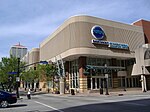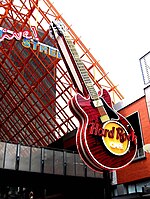Tyler Hotel
1910 establishments in Kentucky1995 disestablishments in KentuckyBuildings and structures demolished in 1995Demolished buildings and structures in Louisville, KentuckyDemolished but still listed on the National Register of Historic Places ... and 6 more
Demolished hotels in the United StatesHotel buildings completed in 1910Hotel buildings on the National Register of Historic Places in KentuckyJefferson County, Kentucky Registered Historic Place stubsLouisville, Kentucky building and structure stubsNational Register of Historic Places in Louisville, Kentucky

The Tyler Hotel opened in 1910 at Third and Jefferson Streets in Louisville, Kentucky, and for many years it was the only major hotel in the northern part of downtown. The hotel became the Earle Hotel in the late 1940s and then the Milner Hotel in the early 1960s after its new owner, Earle Milner. In 1995, it was torn down to make space for the Kentucky International Convention Center.
Excerpt from the Wikipedia article Tyler Hotel (License: CC BY-SA 3.0, Authors, Images).Tyler Hotel
South 4th Street, Louisville
Geographical coordinates (GPS) Address Nearby Places Show on map
Geographical coordinates (GPS)
| Latitude | Longitude |
|---|---|
| N 38.2537 ° | E -85.7554 ° |
Address
Kentucky International Convention Center (Commonwealth Convention Center)
South 4th Street 221
40202 Louisville
Kentucky, United States
Open on Google Maps









